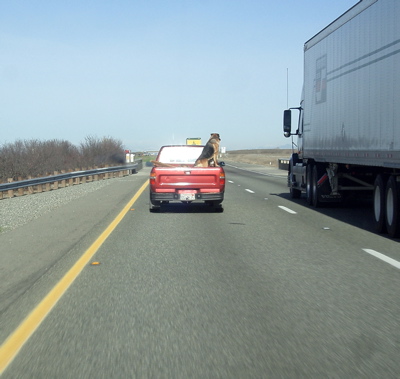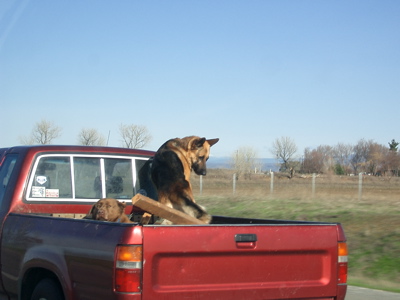
Sunday on Interstate 5, getting close to Red Bluff in the northern Sacramento Valley. You get used to seeing all sorts of interesting dog antics in moving vehicles. A neighbor is fond of driving around with his beagle on his lap, sticking its head out of the driver’s window for a better look at the passing scenery. Cute, I guess, but fundamentally dumb (why, for instance, should the dog get tangled up in the deploying airbag when the inevitable comes to pass? For now, we won’t discuss the merits, or lack of same, of taking pictures while driving; besides, I only took the picture above).
So here’s a little pickup truck moving at the I-5 speed limit, 70, with one very active passenger in the back. The dog’s ability to get his head out into the wind and keep his balance was pretty impressive. But again, it seemed fundamentally dumb on the driver’s part. Regardless of the dog’s agility, Newton’s laws (see “bodies in motion,” etc.) are in full force on the nation’s highways; it doesn’t seem like it would take much to separate dog from vehicle. Later, I wondered whether the loose dog in the back was breaking more recently announced (though perhaps less universal) laws.
California (and probably most other states) requires that dogs in pickups be cross-tethered or in a secured carrier so they don’t go tumbling into traffic. But the apparently pertinent passage of state law — California Vehicle Code Section 23117 — includes an interesting set of exceptions. Dogs don’t need to be secured if their owner is a farmer or rancher (or works on a farm or ranch) and they’re being transported on a road in a rural area or to and from a livestock auction; and they can be loose in the truck, apparently, if they’re being transported “for purposes associated with ranching or farming.”
Still. Seventy miles an hour on an interstate seems like a stretch. When we were passing the truck after the first picture was taken, we saw there was a second dog in the bed of the truck, too. But it had a more hunkered-down approach to highway travel.

